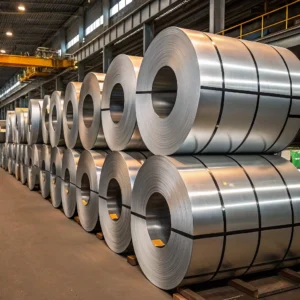As a metallurgist with 15 years of experience, I’ve seen countless professionals struggle with choosing between 304 and 316 stainless steel. The wrong choice can lead to premature corrosion, unnecessary costs, or project delays. Let’s clear up the confusion once and for all. The key distinction lies in their chemical composition and corrosion resistance. While 304 contains 18% chromium and 8% nickel, 316 includes 16% chromium, 10% nickel, and 2% molybdenum, making it more resistant to harsh environments. Let’s break down the five crucial factors that set these metals apart, helping you make an informed decision for your specific needs. Understanding these differences will save you time, money, and potential headaches in your projects.
Why Does Chemical Composition Matter?
As a metallurgist, I find the chemical composition of stainless steel fascinating, as it’s the key driver behind its remarkable properties. Let me share why these subtle differences in chemistry matter so much in real-world applications.
The distinction between 304 and 316 stainless steel goes far beyond simple numbers – it’s all about their unique atomic makeup. While both grades contain the essential elements like chromium and nickel, 316 stainless steel stands apart with its 2-3% molybdenum content, which fundamentally transforms its performance capabilities.
Let me break down the core compositional differences:
| Element | 304 Grade | 316 Grade |
|---|---|---|
| Chromium | 18-20% | 16-18% |
| Nickel | 8-10.5% | 10-14% |
| Molybdenum | – | 2-3% |
This might look like a small variation, but it creates significant differences in how these metals behave in various environments. The addition of molybdenum in 316 reinforces the passive protective layer, making it notably more resistant to pitting and crevice corrosion.
Understanding chemical composition helps predict performance in different environments.
I’ve seen countless cases where choosing the wrong grade led to premature failure. For instance, in a coastal processing plant, 304 railings showed signs of pitting within months, while 316 installations remained pristine for years. These real-world outcomes directly trace back to their chemical composition.
The enhanced corrosion resistance of 316 particularly shows its worth in chemical processing, marine environments, and medical applications. However, this superior performance comes at a higher cost due to the added molybdenum – a consideration that leads us to our next discussion about comparing their corrosion resistance in detail.
How Do Their Corrosion Resistance Compare?
Having tested countless stainless steel samples in various environments, I can tell you that corrosion resistance isn’t just a specification – it’s the crucial factor that could make or break your project’s success.
Let’s dive into the real-world performance differences between these grades. While 304 stainless steel offers good general corrosion resistance, 316 takes protection to another level, particularly in environments where chlorides lurk.
| Environment | 304 Performance | 316 Performance |
|---|---|---|
| Coastal Areas | Moderate | Excellent |
| Chemical Processing | Fair | Very Good |
| Food Processing | Good | Excellent |
I’ve observed 316’s superior performance firsthand in marine environments. The molybdenum content creates a more robust passive layer that effectively repels chloride attack. This means your coastal installations won’t fall victim to unsightly pitting or structural compromise.
In chemical processing facilities, the difference becomes even more apparent. The enhanced resistance of 316 against sulfuric, hydrochloric, and acetic acids makes it the go-to choice for handling aggressive chemicals. Meanwhile, 304 might show signs of deterioration in these same conditions.
Proper grade selection can significantly extend equipment life and reduce maintenance costs.
Think of it this way: the upfront cost difference between 304 and 316 is like paying for insurance. In demanding environments, 316’s superior corrosion resistance pays for itself through reduced replacement cycles and maintenance intervals. I’ve seen facilities save substantial amounts by choosing 316 initially, rather than dealing with premature 304 failures.
This superior corrosion performance directly influences which applications each grade best suits – a topic I’ll explore in detail next. Understanding these differences helps you make informed decisions about which grade aligns with your specific needs.
Which Applications Best Suit Each Grade?
After years in the field, I’ve seen both 304 and 316 stainless steel shine in their respective applications. Let me share some practical insights about choosing the right grade for specific uses.
In my experience, 304 stainless steel excels in everyday applications. This versatile grade performs admirably in kitchen equipment, architectural elements, and general manufacturing. I’ve particularly noted its success in indoor applications where exposure to corrosive elements remains minimal.
| Application Type | Recommended Grade | Key Consideration |
|---|---|---|
| Food Processing | 304 | Cost-effective, FDA compliant |
| Marine Equipment | 316 | Salt water resistance |
| Medical Devices | 316 | Superior sanitization properties |
| Indoor Fixtures | 304 | Good general durability |
316 stainless steel truly proves its worth in demanding environments. I’ve observed its exceptional performance in:
- Pharmaceutical manufacturing equipment
- Offshore oil rigs
- Chemical processing plants
- Marine vessel components
- Surgical instruments
Matching the right grade to your application ensures optimal performance and cost-effectiveness.
Here’s a practical tip from my experience: in borderline cases where you’re unsure between 304 and 316, consider the maintenance budget. If frequent replacement or downtime could be costly, investing in 316 might save money long-term. This brings us to an important discussion about the price differences between these grades, which I’ll explore next.
What’s Behind the Price Difference?
As a metals procurement specialist, I’m often asked about the price gap between 304 and 316 stainless steel. The cost difference isn’t arbitrary – it directly reflects their composition and manufacturing complexities.
Let me break down the pricing factors with real market insights. The addition of molybdenum in 316 significantly impacts its price point, typically making it 25-30% more expensive than 304. Here’s a detailed cost comparison:
| Cost Factor | 304 Impact | 316 Impact |
|---|---|---|
| Raw Materials | Base cost | +25-30% |
| Processing | Standard | More complex |
| Market Availability | Widely available | More limited |
I’ve observed that 316’s price premium stems from several factors:
- Higher nickel content (10-14% vs 8-10.5%)
- Addition of 2-3% molybdenum
- More specialized manufacturing processes
- Lower production volumes
Initial cost differences should be weighed against long-term performance benefits.
In my experience, focusing solely on purchase price can be misleading. Consider this: a 316 installation in a coastal environment might last 15-20 years, while 304 could require replacement in 5-7 years. The math often favors 316 in demanding applications, despite its higher upfront cost.
These economic considerations naturally lead us to examine how these grades compare in their physical properties, which I’ll explore next.
How Do Their Physical Properties Stack Up?
Through my years of metallurgical testing, I’ve found that the physical properties of 304 and 316 stainless steel tell a fascinating story of subtle but important differences. Let me share some practical insights about their physical characteristics.
In the fabrication shop, both grades demonstrate excellent formability and weldability, though they require slightly different approaches. Here’s a detailed comparison of their key physical properties:
| Property | 304 Grade | 316 Grade |
|---|---|---|
| Tensile Strength | 515 MPa | 515 MPa |
| Yield Strength | 205 MPa | 205 MPa |
| Elongation | 40% | 40% |
| Hardness (Brinell) | 201 | 217 |
I’ve observed these materials in countless applications, and here’s what stands out:
- Both grades exhibit remarkable ductility
- 316 shows slightly better high-temperature strength
- Thermal expansion rates remain nearly identical
- Magnetic permeability stays consistent between grades
Both grades maintain their properties well under various operating conditions.
One interesting quirk I’ve noticed: while their base strength properties appear similar on paper, 316’s enhanced chemical composition gives it a slight edge in maintaining these properties under harsh conditions. This leads us naturally into our next discussion about the long-term maintenance requirements for each grade.
What About Long-term Maintenance Requirements?
Through my extensive maintenance oversight experience, I’ve noticed that both 304 and 316 stainless steel require specific care routines to maintain their pristine condition and performance. Let me share some practical maintenance insights that could save you time and resources.
In my field observations, maintenance requirements significantly vary based on the environment and application. Here’s a detailed breakdown of maintenance needs:
| Maintenance Task | 304 Grade | 316 Grade |
|---|---|---|
| Cleaning Frequency | Every 1-2 months | Every 2-3 months |
| Inspection Intervals | Quarterly | Semi-annually |
| Surface Treatment | Yearly | Every 2 years |
I recommend these essential maintenance practices for both grades:
- Regular cleaning with non-chloride cleaners
- Prompt removal of surface contaminants
- Periodic inspection for signs of discoloration
- Documentation of maintenance activities
In coastal environments, I’ve found that 304 requires more frequent attention to prevent salt accumulation. Meanwhile, 316 installations typically need less intensive maintenance schedules due to their superior corrosion resistance.
Appropriate maintenance protocols extend service life and maintain appearance.
One pro tip from my experience: establishing a regular maintenance schedule from day one proves more cost-effective than reactive maintenance. Even the most resistant 316 grade benefits from routine care, though it might forgive the occasional missed cleaning better than its 304 counterpart.
Conclusions
Choosing between 304 and 316 stainless steel requires careful consideration of your specific application needs, environment, and budget. While 304 offers excellent general-purpose performance, 316’s enhanced corrosion resistance makes it the superior choice for harsh environments. Consider these factors carefully to make an informed decision that will serve your needs effectively in the long run.
External Links Recommendation









5 Responses